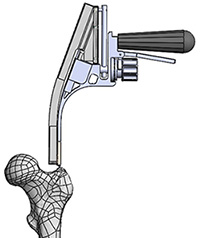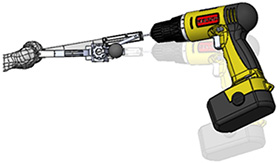Femoral Antegrade Starting Tool (FAST)

Challenges in intramedullary (IM) nailing of long bone fractures arise during the entry point step in which 2D fluoroscopic imaging is used to guide 3D alignment of a guidewire safely into the IM canal. Specifically, the guidewire alignment achieved under fluoroscopy in one plane may be lost while adjusting the alignment in the orthogonal plane. This impedes the surgical workflow requiring unpredictable repetition of surgical activities (e.g. repeated fluoroscopic repositioning) and leads to frustration in the operating room. Such challenges are particularly evident in large (muscular and obese) patients.
FAST (Femoral Antegrade Starting Tool) is an innovative surgical tool that facilitates entry point selection and insertion for IM nailing. FAST enables maintenance of guidewire (Kirschner (K) wire) anteroposterior (AP) alignment during lateral imaging and K-wire positioning in the sagittal plane addressing both localization and orientation challenges that arise from the use of 2D imaging to achieve 3D alignment.

In use for femoral fracture stabilization, the initial FAST device entry point placement is conducted freehand at the greater trochanter under fluoroscopic image guidance. The device location and orientation are adjusted until satisfactory AP alignment is obtained. The device is fixed onto the greater trochanter, locking the AP alignment. Under lateral fluoroscopic imaging, the K-wire is inserted into a channel of the FAST device best aligned with the medullary canal. The FAST arm is rotated in plane to achieve optimal lateral alignment. With alignment optimized in both planes, the K-wire can be safely drilled into the bone. This workflow has been shown in preclinical study to minimize time and radiation exposure from fluoroscopic imaging in femoral IM nailing. A first-in-human trial of FAST was successfully completed in 2019.


